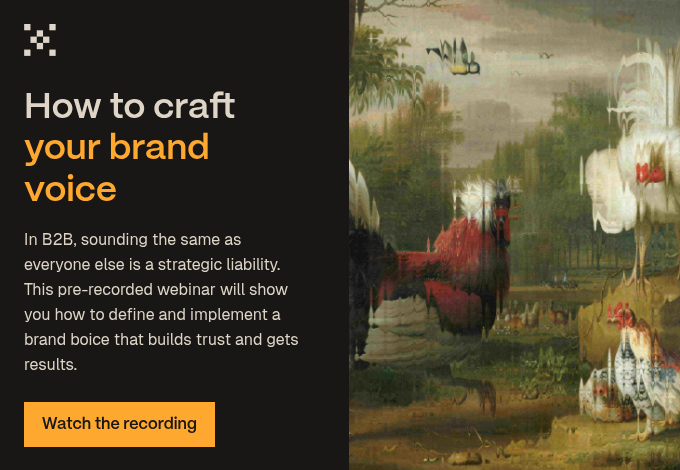This article shares the high-level takeaways from a webinar run by our CEO and Founder, Matthew Stibbe. To catch every pearl of wisdom, watch the full webinar here (gated content).
Email might be a dead medium for internal communications or project management, but it’s having a renaissance for marketing.
This rise in popularity might have something to do with its return-on-investment (ROI.) According to VentureBeat (via Campaign Monitor), email has generated the highest ROI for marketers 10 years running. It equates to $38 ROI for every $1 spent, which is staggering.
But it’s not as simple as copy-pasting your sales pitches into a nice template. Email marketing is its own discipline with its own best practices to see the greatest returns.
In this article, we’ll share the six steps to crafting emails your target audience will actually want to read, from subject lines to segmentation to testing.
Start with irresistible subject lines
‘The subject line is the invitation to the party,’ explains Matthew, CEO and Founder of Articulate Marketing. If your email doesn’t get opened, nothing else matters.
You’re aiming for short, punchy sentences that instantly indicate the benefits for the audience. Strong verbs and clear language that spell out the value of opening and reading.
Take it from a writer—writing shorter copy is often harder than drafting a full article. A surefire method for creating great subject lines comes from Matthew’s writer’s bible, ‘Writing to Deadline’ by Donald Murray.
In it, Donald recommends writing 50 headlines for an article to unpack the story, but you can apply the same principle for subject lines. Write 5-10 subject lines (or 50, if you have the time!) Then ask yourself these questions to narrow down your options:
- Is the benefit or value inside the email clear from the subject line?
- Will the tone of voice resonate with your target audience?
- Is it the right angle for our audience, right now?
Amplify your brand voice
Successful emails sound human. They have a distinct voice that readers can recognise instantly. Matthew points to writers like Seth Godin and Scott Galloway as good examples—opinionated, clear and consistent in their tone.
Your tone of voice should be as intentional as your website or logo design. You also need to apply it consistently for maximum impact, which is where your friendly neighbourhood AI can help out.
Matthew advises against letting AI take the wheel completely: ‘You’ve all had these emails that have obviously been written by AI… they don’t say anything particularly interesting.’ But they can help you refine and polish your copy.
The key takeaway: write your message of substance first, then use AI (if you wish) to iterate, edit and improve.
Lead with value and thought leadership
‘I love the endless stream of generic sales pitches in my inbox!’ said no buyer ever.
Matthew’s twist on the conventional sales wisdom is, ‘always be helping.’ Share insights, stories, and useful information that help your audience do their job better or see the world differently.
This might mean sharing case studies in the form of engaging narratives rather than dry problem-solution-benefit stories. Or it might mean linking to blog posts, webinars, or other resources where readers can go deeper.
The key is to be relevant and generous with your expertise. If you consistently deliver valuable content, you’ll build trust. Then, when it’s time to sell, your audience will be ready to listen.
Segment and personalise thoroughly
Relevance is about the right message, the right moment and the right medium. As such, Matthew impresses the importance of segmentation for effective emails: ‘If you’ve got a database of 20,000 people, find the 2,000 that share some characteristic you can talk to.’
You can segment by persona, job title, geography, industry or engagement level. Tools like HubSpot can automate much of this, but the underlying data must be clean and up to date.
Another easy win is sending marketing emails from a real person rather than a generic ‘no-reply’ address. It humanises the interaction and makes it easier for recipients to reply, which can yield valuable signals about job changes and contact validity.
Nail the technical details
Even perfect-fit content for your personas won’t perform if your emails never make it to the inbox. Here are some key areas to check to ensure brilliant copy and conversion-rate optimisation (CRO) doesn’t go to waste:
- Sender Policy Framework (SPF), DomainKeys Identified Mail (DKIM) and Domain-based Message Authentication Reporting and Conformance (DMARC): Check they’re properly configured, which you can do using free tools like easydmarc.com
- The ‘spam factor’ of your content: Emails that sound or look like spam are more at risk of falling into junk folders. Tools like mail-tester.com or spamcheck.postmark.com can help you assess this (for free!)
- Easy unsubscribe button: Nothing will turn an indifferent reader into a lifetime detractor faster than struggling to unsubscribe to your email. Making it easy (ideally, with just one click) to unsubscribe is better than having your email reported as spam.
- Double opt-in: Sending a follow-up email which asks a user to confirm, by clicking a link, that they definitely want to subscribe gets their wholehearted consent for your content. This helps mitigate misclicks and helps ensure sign-ups via gated content don’t feel duped.
Keep monitoring your email health using these tools and your email client and you’ll never have to wonder if it’s your content or technical gremlins affecting performance.
Test, learn, repeat
Finally, treat every email as an opportunity to learn and create better emails. A/B testing isn’t just for subject lines. You can also A/B test:
- Email formats
- Information hierarchy
- Calls-to-action
- Send times
Small improvements can have a big cumulative effect. At Articulate, we’ve seen subject line tests deliver 5-10 per cent uplifts in open rates.
What works for one audience may not work for another, so keep segmenting and keep testing.
Excel at more than email marketing
If you want more from your marketing emails, do more than just avoiding the spam folder. Show up in your audience’s inbox with something they’re genuinely glad to see.
Watch the full email marketing webinar from our CEO and Founder, Matthew Stibbe, to get even more expertise on honing your email approach. And if you want even more expert marketing advice, visit our webinar page for past talks on AI and automation, websites, thought leadership and beyond.

 Posted by
Maddie Saunders
Posted by
Maddie Saunders
.jpg?width=1600&height=800&name=europeana-9N27AE6bAKc-unsplash%20(1).jpg)





